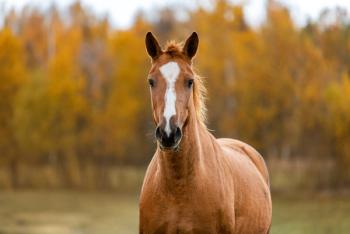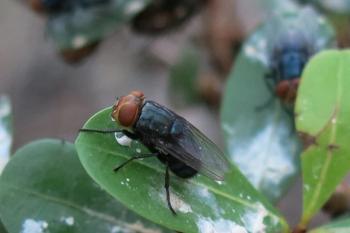
Cast away
For most adolescents it was a rite of passage. Signed and decorated by their friends, it was that itchy, white-plaster cast on his/her wrist, arm or ankle. It may have been acquired from a bike, skateboard or skiing mishap, a sports injury from football or hockey or just a fall on the ice.
For most adolescents it was a rite of passage. Signed and decorated by their friends, it was that itchy, white-plaster cast on his/her wrist, arm or ankle. It may have been acquired from a bike, skateboard or skiing mishap, a sports injury from football or hockey or just a fall on the ice.
New developments: Casts continue to evolve to reduce the stress on an injured tendon, ligament or bone.
These casts were heavy, scratchy and hot. The same was true in equine practice. Expertise and experience were required to successfully apply a functional plaster leg cast. They figured prominently in attempts to repair fractures in legendary horses such as Ruffian and yet, many times, poor acceptance by the horse or the development of cast sores limited their usefulness.
Still, the plaster cast was a part of advanced orthopedic care in the 1900s and figured prominently in both human and equine fracture repair.
New developments in materials ensued, however, and fiberglass soon became the casting material of choice. By the 1980s that old crumbly, itchy plaster cast was beginning to disappear for both humans and horses. Fiberglass casts were 20-times stronger than plaster, one-fourth the weight and both durable and waterproof. They became commonly used for many equine injuries ranging from angular limb deformities to tendon injuries to laceration repair stability as well as for support in fracture fixation.
Fiberglass is still used today but medical advances march on. Once again, new developments in materials and methods of bracing may soon make even fiberglass casts obsolete in equine practice.
Limiting range of motion
Fiberglass casts are currently used in equine practice for a number of reasons. A primary use is for the immobilization of the distal or lower limb following tendon repair or similar surgery. Keeping the limb from flexing and extending reduces the stress on the injured tendon or ligament and allows the area time to heal. Fiberglass casting is similarly used following plastic or reconstructive surgery to limit the range of motion of the limb and allow a period of initial healing without skin edges being pulled apart. Transfixation casts, which use pins placed through bones and incorporated in the cast, are used as aids in the fixation of fractures. Occasionally fiberglass casts are used alone to treat some types of non-displaced or simple fractures in certain areas. Casts are especially useful for the treatment of hoof-wall defects and some heel-bulb lacerations.
Proper case selection for cast use is important. Practice and experience are required for correct application. There are certain principles for fiberglass casting that should always be followed. Patient motion during the casting process and during the curing of the cast itself can cause pressure points and poor cast fit so general anesthesia is usually recommended.
This first principle can be problematic for many equine cases and especially so for practitioners attempting to treat a horse in a field or barn. Some equine injuries are unstable enough that the risk of anesthesia and recovery may further jeopardize these patients. Indeed, many horses have been successfully repaired surgically only to have problems occur during recovery which may include failure of the surgical implants and/or cast damage. Standing tranquilization and good handling techniques may make cast application possible with select cases and while not optimum, such procedures can still be successful.
The area to be placed in a cast should be clean and dry. Draining incisions, open wounds or lacerations must be covered with non-adherent dressings and these casts will need to be removed and replaced more frequently to allow examination and monitoring of the wounds. Minimal cast padding should be used over possible pressure points. Too much padding leads to slippage and rotation of the cast, and improper fit cause sores and compromises cast function. Casting principles state that the cast should be long enough to immobilize the joints above and below the lesion and that the upper and lower ends of the cast should be sealed with a collar of elastic adhesive tape to eliminate the entrance of foreign material.
A good cast will provide rigid immobilization and support, and these are the two features that make fiberglass casts a good choice for some equine patients. The correct casting principles are not always easy or even possible to follow. Equine practitioners often fear the complications of improper cast placement, which can be more devastating than the initial injury itself, and are reluctant to utilize casts.
The right balance: Proper case selection for cast use is important, equine veterinary experts say. Experience is required for correct application.
"Many wounds, fractures and lacerations are associated with a good deal of swelling which can make cast application difficult," says Dr. Norm Ducharme, equine surgeon and medical director of the equine and farm animal hospitals at the New York State College of Veterinary Medicine at Cornell University. "If a cast needs to be applied when swelling exists, then as the swelling resolves the cast will loosen. It will need to be changed throughout the healing process," Ducharme explains. Constant and vigilant monitoring of these horses is required which is difficult for some owners and hard to ensure with field cases.
Likewise, young foals and growing horses will need frequent cast changes because their limbs will constantly be altered due to growth. Ducharme estimates the general maximal time for a single cast use to be roughly three weeks in an adult horse under the best of situations and 10 days or so for young horses. When surgeons began factoring the experience needed for proper cast placement and management, the cost of fiberglass cast changes and the risks of anesthesia and/or sedation for each change, it soon became obvious that perhaps a better system was needed.
Dr. Augusto Sarmiento, a human physician practicing at the University of Miami in 1963, began using a series of metal hinges along with plaster and other casting material to create braces to help in the repair of various fractures.
This was the beginning of fracture bracing, and this method of stabilizing fractures and other various limb injuries emerged into a very functional, extremely versatile and increasingly accepted way to stabilize limb injuries. Materials have evolved and now low-temperature thermo-moldable plastics are used to create these braces.
Bob Frank, a board-certified orthotist, prosthetist and president of Equine Bracing Solutions in Trumansburg, N.Y., acknowledges, "Even though fracture bracing was introduced more than 25 years ago many surgeons, human and equine, initially said that they felt more comfortable putting patients in fiberglass casts, but now it is about 50-50 between fiberglass casts and bracing products."
Ducharme is quick to point out that fiberglass casting still provides the best stability.
"A good cast will immobilize better than the best brace," he says. But newer braces are constantly improving the amount of stability. Both experts agree there are some significant advantages to bracing products. Equine braces are generally bi-valved, meaning they are made of two molded sections that fit together to encase the injured area. A series of straps or hook-and-loop attachments hold the two pieces together, and the resultant brace is form fitted and rigid but can be easily removed and put back on quickly.
This aspect of braces makes them less likely to produce sores, inflammation and irritation along the limb. The horse generally tolerates these devices very well, and the constant monitoring that is possible with easy removal and replacement allows for better management of open wounds. Additionally braces can be continually adjusted to account for changes in swelling reduction, muscle atrophy or growth.
Cost equation
"Economics can also be a factor because a brace (prices can be up to $800 or more for custom models) may be less expensive if a standard fiberglass cast (including anesthesia/sedation, bandage and cast materials and doctor time) must be replaced more than twice," Ducharme says.
While bracing techniques may not totally replace the use of fiberglass casts, these devices "should be considered as a viable option for fracture and injury management and as an economical alternative to standard circumferential casting methods," according to Dr. Paul Webber, a member of the American Academy of Orthotists and Prosthetists.
Ducharme agrees and feels that equine practitioners will gradually begin to increase their use of these devices stating, "I think bracing techniques will replace a lot of cast use when practitioners become more comfortable with them."
Comfort was certainly a factor in the disappearance of the old itchy plaster cast and a comfort level with what bracing devices can do for horses.
Newsletter
From exam room tips to practice management insights, get trusted veterinary news delivered straight to your inbox—subscribe to dvm360.




